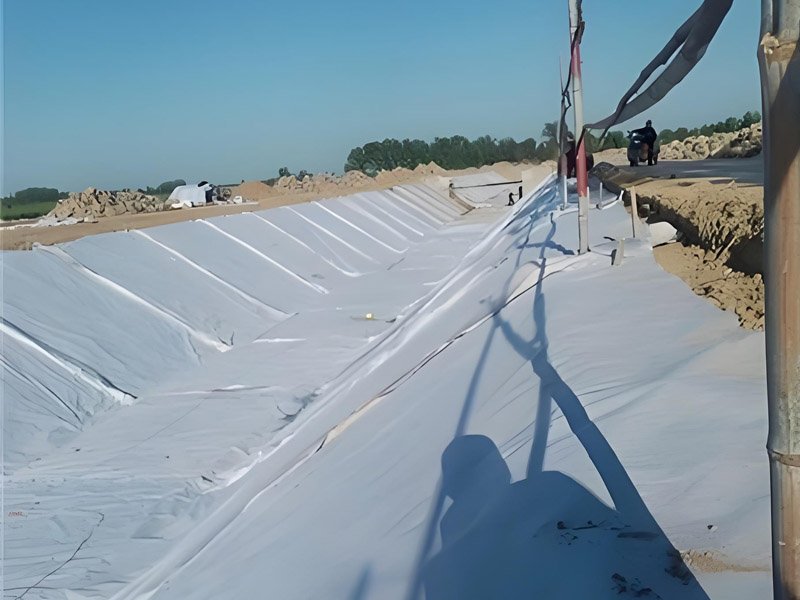Geotextiles, with a weight of 400g per square meter, are essential materials in the field of civil engineering due to their durability and versatility. BPM Geosynthetics, a leading company in this sector, has been instrumental in producing high-quality geotextiles that meet the rigorous demands of various construction projects. These Geotextile 400g are widely used for soil stabilization, erosion control, and drainage systems, making them indispensable in modern infrastructure development.
1. What Is Geotextile 400g?
Geotextile 400g, a geotextile fabric weighing 400 grams per square meter, plays a crucial role in various civil engineering projects like roads, embankments, and drainage systems. These fabrics, designed to be permeable, serve multiple functions such as separation, filtration, reinforcement, protection, and drainage, adapting to the distinct needs of each project.
Geotextiles are classified based on weight, with different weights tailored for specific applications. The weight of a geotextile fabric significantly influences its strength, durability, and filtration capabilities. Geotextile 400g, being relatively heavy compared to lighter alternatives, is preferred for tasks that demand increased strength and enhanced filtration abilities.


2. What Types of Geotextile 400g Are There?
Geotextile fabrics weighing 400 grams per square meter can be crafted from a variety of materials tailored to the project’s unique demands. These materials commonly include:
2.1 Polypropylene
Polypropylene is recognized for its resistance to decay, chemicals, and biological breakdown. It is a favored choice for geotextiles due to its robustness. Additionally, polypropylene provides longevity in applications requiring durable materials.
2.2 Polyester
Polyester geotextiles excel in stability. They offer exceptional resistance to stretching and contraction. This makes them ideal for projects requiring structural integrity.
2.3 Polyethylene
Geotextiles made from polyethylene showcase resilience against acids. They also resist alkalis and biological agents. This makes them suitable for environments where chemical endurance is vital.
2.4 Natural Fibers
Some geotextiles utilize natural fibers like jute or coir. These materials offer biodegradability. They are often preferred for environmentally sensitive applications.
2.5 Composite Materials
Composite geotextiles blend various fibers. They do this to achieve specific performance characteristics. This tailoring allows the fabric to meet precise project requirements.
3. How Does The Weight (400 gsm) Affect Geotextile’s Performance?
The weight of a geotextile fabric, such as 400 grams per square meter (gsm), significantly influences its performance in various civil engineering applications. Here’s how the weight can affect the geotextile’s performance:
3.1 Strength and Stability
Heavier geotextiles generally offer greater strength and stability compared to lighter options. A 400 gsm geotextile is an example of a heavier option. It is likely to provide better reinforcement and support in applications where higher loads or stresses are present.
3.2 Filtration and Separation
The weight of the geotextile can impact its filtration and separation capabilities. A heavier geotextile, such as a 400 gsm fabric, generally offers enhanced performance in this regard. It may provide better filtration by effectively preventing soil particles from passing through while still allowing water to flow.
3.3 Durability:
In many cases, heavier geotextiles are more durable and resistant to damage over time. A 400 gsm geotextile is an example of a heavier option. It is likely to have greater longevity and withstand harsh environmental conditions better than lighter alternatives.
3.4 Erosion Control:
The weight of a geotextile can influence its effectiveness in erosion control applications. Heavier geotextiles are often more successful at stabilizing soil and preventing erosion. This makes them particularly useful in areas prone to washing away.
3.5 Installation and Handling:
Heavier geotextiles may be more challenging to install due to their weight. This can require more effort and potentially specialized equipment during installation. However, the added weight can also make them easier to handle once in place.
3.6 Cost:
Generally, heavier geotextiles tend to be more expensive. This is due to the additional material required to manufacture them. The cost implications of using a 400 gsm geotextile should be considered in the overall project budget.


4. What Are The Applications Of Geotextile 400g?
Geotextile 400g has extensive applications in industrial projects due to its strength, durability, and ability to withstand harsh conditions. Here are some key industrial applications:
4.1 Industrial Landfills
- Leachate Barriers: Used as a barrier to prevent leachate from contaminating the surrounding environment.
- Cover Systems: Provides a durable cover for landfill sites, reducing erosion and promoting drainage.
4.2 Mining Operations
- Tailings Dams: Reinforces tailings dams, preventing seepage and erosion while providing structural stability.
- Stockpile Stabilization: Helps stabilize stockpiles of aggregates, ores, or other materials, reducing dust and erosion.
4.3 Oil and Gas Industry:
- Asphalt Plants: Used in asphalt plants to separate aggregates and reduce dust emissions.
- Containment Ponds: Provides lining and reinforcement for containment ponds, preventing leakage and environmental contamination.
4.4 Construction Sites:
- Temporary Roads: Creates temporary roads that can withstand heavy machinery and traffic during construction.
- Scaffolding Support: Used as a support layer under scaffolding to distribute loads and prevent sinking into soft ground.
5. Summary
Geotextile 400g, known for its robust strength and durability, is a versatile material extensively utilized in various industrial projects. Its applications span across erosion control, slope stabilization, roadway and railway reinforcement, contributing significantly to long-term stability and environmental protection. This high-performance geotextile not only bolsters the structural integrity of industrial sites but also supports sustainable development by mitigating soil erosion and contamination. At BPM Geosynthetics, we pride ourselves on offering premium quality geotextiles like the 400g variant, ensuring reliability and efficiency in every project. We invite collaboration to leverage our expertise and advanced materials, fostering innovation and excellence in geotechnical engineering solutions. Together, let’s build a stronger, more sustainable future.





